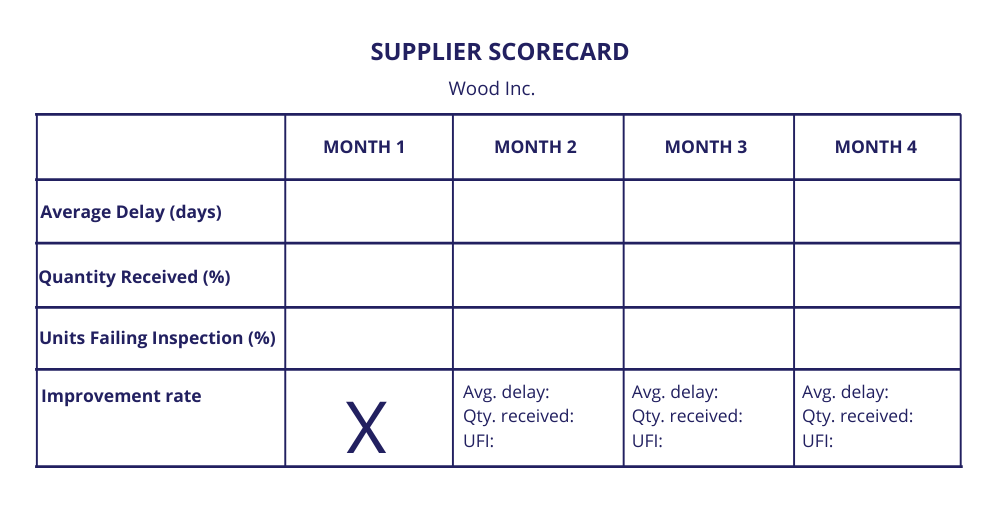11 Supplier Relationship Management Tips for Growing Businesses
Supplier relationships play a major role in the effective operations of most companies that deal with physical inventory. The goal of supplier relationship management is to foster strong partnerships that benefit both the buyer and the seller.

You can also listen to this article:
What is supplier relationship management?
Supplier relationship management (SRM, also known as vendor relationship management) is a critical aspect of procurement and supply chain management that focuses on developing better supplier relations. The goal of SRM is to create and nurture mutually beneficial relationships with key suppliers, improving purchase terms, increasing overall profitability, and sharpening the competitive edge of a business.
For effective supplier relationship management, procurement needs to be transformed into a strategic function. This involves the segmentation of the supplier base, identifying strategically important suppliers, and developing partnerships that go beyond simple transactions. By focusing on supplier performance management through supplier data, metrics, and scorecards, businesses can ensure a two-way flow of information, leading to continuous improvement.
Benefits of supplier relationship management
Supplier relationship management is a strategic approach in procurement and supply chain management that could yield significant benefits. These include:
- Improved supplier performance. By implementing effective SRM strategies, companies can monitor supplier performance using KPIs and scorecards. This performance data can be used to give constructive feedback to suppliers, enabling them to correct any shortcomings.
- Cost savings. Better supplier relationships often mean better purchase terms, lower prices, and less time spent on purchasing activities.
- Stronger, mutually beneficial partnerships. SRM fosters deeper, more strategic partnerships with key suppliers. This two-way collaboration ensures both parties benefit, leading to better service, quality, and reliability.
- Competitive advantage. Adopting a strategic approach to SRM can give companies a competitive edge. Through strategic sourcing and supplier segmentation, businesses can streamline their supply base and focus on strategic suppliers, improving overall market responsiveness. In addition, the cost savings yielded by better supplier relationships have a direct effect on the bottom line.
- Streamlined procurement processes. Supplier relationship management streamlines purchasing through the strategic alignment of purchasing and business goals. SRM also often involves the use of an ERP system, which aids in increasing efficiency and eliminating waste across the operation.
- Better risk management. Having strong relationships with strategic partners enables companies to stay flexible and mitigate the risk of disruptions.
- Alignment with business strategy. Successful SRM ensures that supplier strategies are in sync with broader business objectives. Strategic supplier relationships and effective contract management contribute to achieving long-term business goals.
All in all, supplier relationship management contributes to the optimization of procurement processes, mitigation of risks, reductions in costs, and, ultimately, the attainment of strategic business goals and increased profitability.
11 supplier relationship management tips for growing businesses
Implementing proper supplier relationship management processes is especially important for businesses that are growing or looking to grow. As product volumes increase, it is necessary to ensure that your vendors are on the same page with you in terms of projected demand and budgetary constraints. Here are some tips that growing businesses can follow to improve their supplier relationship management strategy and workflows.
Carefully select suppliers
First of all, select new suppliers based on mutual values such as commitment to sustainability, appropriate age workers, and other ethical considerations. Next, assess their credit history and ability to fulfill your orders according to projected growth. Create standard operating procedures for evaluating each vendor candidate.
Create an onboarding process
Onboarding is a critical phase for new suppliers, involving the introduction to the company’s policies, procedures, and expectations. This step ensures that new suppliers understand their role and the standards they need to meet. Effective onboarding facilitates smoother operations and sets the foundation for a strong relationship.
Segment your suppliers
Segmenting suppliers involves categorizing them based on various criteria such as their importance to the business, supplier risk level, spending, and performance.
First, identify suppliers that are critical to your business operations and strategic goals. Next, assess each supplier’s impact on your supply chain’s risk and profitability.
Suppliers can then be grouped into categories. One of the most popular methods for this is the Kraljic Matrix, which divides vendors into:
- Strategic suppliers. These are vendors that are critical to your business as they either sell unique goods not available elsewhere or exhibit product quality that significantly tops their competition. Relationships with these suppliers require the most care and effort.
- Bottleneck suppliers. These suppliers offer products that are unique or have few alternatives but are less critical to your business. Managing risk is of high priority here as well, as any disruption might have a significant impact due to a lack of substitutes.
- Leverage suppliers. These providers sell goods that are important but not unique, with many alternatives on the market. In this category, the focus should be on negotiating favorable terms and prices due to the competitive landscape.
- Non-critical suppliers. This group includes suppliers that provide standard products that can easily be replaced. In this category, procurement processes can be simplified and even automated, thereby minimizing costs related to this category.
This segmentation enables focused supplier relationship management initiatives, ensuring resources are allocated efficiently to manage and develop relationships with each supplier category appropriately.
Establish clear communication channels
Effective communication is the backbone of any strong supplier relationship. Establishing clear communication channels ensures that both parties can easily share information, updates, and concerns. This might include regular meetings, direct lines of contact, and digital platforms for day-to-day interactions. Clear channels help resolve issues quickly, align expectations, and foster transparency, which is essential for trust and collaboration.
Pay on time
Prompt payment is a simple yet powerful way to build trust and reliability with your suppliers. It demonstrates your commitment to a fair and professional relationship. On-time payments help suppliers manage their cash flow better, contributing to their operational stability and willingness to go the extra mile for your business needs. It can also position you as a preferred customer, potentially leading to better terms and priority service.
Do not overpromise
Setting realistic expectations is crucial in supplier relationships. Overpromising, whether regarding order volumes, payment schedules, or project timelines, can strain the relationship and lead to dissatisfaction on both sides. Be honest about your needs and capabilities from the start. This transparency helps in building a partnership based on trust and mutual respect, ensuring long-term collaboration.
Define and track KPIs
Key performance indicators (KPIs) are essential for measuring and managing supplier performance effectively. Defining clear, measurable, and mutually agreed-upon KPIs helps both parties understand what success looks like. These metrics can cover various aspects of the relationship, such as quality, delivery timeliness, cost management, and innovation contribution. Create supplier scorecards to easily track and compare your vendors’ performance. Regularly reviewing these KPIs can highlight areas for improvement and drive continuous performance enhancement.

Set clear objectives
Setting clear, achievable objectives for each supplier relationship is vital. These goals should align with your overall business strategy and supply management plans. Objectives can range from cost reduction and quality improvement to innovation and sustainability targets. Having clear goals helps focus initiatives and resources, ensuring that both you and your supplier work towards common outcomes.
Draw up detailed contracts
A detailed contract lays the foundation for a successful supplier relationship. It should clearly outline the terms of engagement, including pricing, delivery schedules, quality standards, and dispute-resolution mechanisms. A well-drafted contract ensures that both parties have a clear understanding of their rights and obligations, reducing the potential for misunderstandings and conflicts.
Provide feedback
Regular, constructive feedback is crucial for maintaining and improving supplier performance. This should not only focus on areas needing improvement but also recognize achievements and contributions to your business. Feedback sessions can be an opportunity for open dialogue, which could foster innovation and help you identify opportunities for further collaboration.
Implement supplier relationship management software
SRM or supplier management software can significantly improve the efficiency and effectiveness of your SRM process. These tools offer features like performance tracking, risk management, and collaborative platforms, enabling real-time insights and streamlined communication. Implementing such software can help automate routine tasks, maintain a centralized database of supplier information, and facilitate strategic decision-making.
Using ERP software to manage suppliers
While there are software solutions that focus specifically on vendor management, an integrated system such as an ERP would fare any company a lot better in the long run. An ERP system brings various functions together across the business, providing a holistic solution that supports vendor relationship management, procurement in general, as well as other essential business processes, such as sales, supply chain management, inventory management, manufacturing, and financial analysis.
More than just a centralized database of operational data, ERP software is designed to improve collaboration both within the company as well as with vendors and clients. Production planning can be tightly aligned with sales and procurement to make sure goods arrive on the shop floor at the right time and orders are fulfilled promptly. Automatically compiled reports can be used to communicate shortcomings or good performance. Order statuses can be easily tracked and customers can be kept up to date on any hiccups in the process.
This automated reporting enables companies to keep a keen eye on the performance of their suppliers: tracking late deliveries, the quality of incoming goods, and price changes among other things enables you to easily assess and compare the performance of your suppliers. Accurate production planning allows you to forecast your material needs for upcoming months or incoming orders, enabling you to schedule purchases quickly and effectively. In addition, purchase orders cannot fall between the cracks when properly using an ERP system. This way, there will not be any missed or duplicate orders, preventing both stockouts and overstocking.
Key takeaways
- Establishing and nurturing mutually beneficial relationships with key suppliers is crucial for improving purchase terms, increasing profitability, and securing a competitive advantage.
- Effective SRM requires transforming procurement from a mere operational activity into a strategic function that focuses on developing strong partnerships and managing supplier performance through data, metrics, and scorecards.
- Implementing SRM strategies can lead to improved supplier performance, cost savings, stronger partnerships, competitive advantage, streamlined procurement processes, better risk management, and alignment with business strategy.
- Selecting new suppliers based on mutual values and capabilities and creating a structured onboarding process are essential for setting the stage for successful supplier relationships.
- Segmenting suppliers based on their importance to the business and their impact on supply chain risk and profitability allows for more focused and efficient management efforts.
- Employing SRM software or integrating ERP systems improves the efficiency and effectiveness of supplier relationship management, supporting better performance tracking, risk management, and strategic decision-making.
Frequently asked questions
Supplier relationship management (SRM) refers to the strategic approach of systematically assessing suppliers’ contributions to a business, developing tactics to maximize suppliers’ performance, and fostering mutual, beneficial partnerships to achieve long-term business goals.
The four types of supplier relationships are strategic partnerships, collaborative relationships, transactional relationships, and adversarial relationships, each varying in terms of collaboration level, commitment, and the strategic value provided to the business.
The three basic components of SRM are supplier segmentation, performance management, and relationship management, encompassing the categorization of suppliers, tracking and improving their performance, and developing strategic partnerships.
You may also like: Procurement Planning – A Simple Guide




